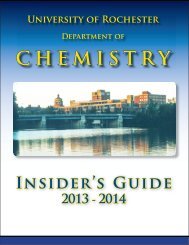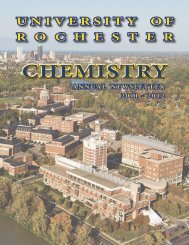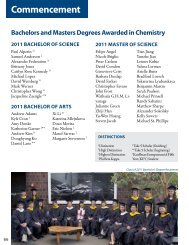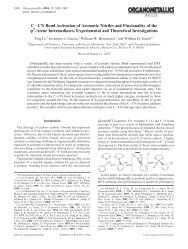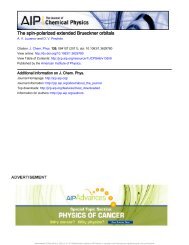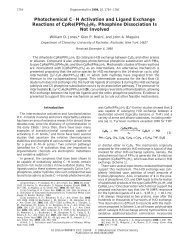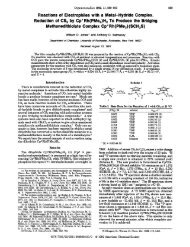Approximation of RRKM Falloff Behavior by Interpolation Formulas
Approximation of RRKM Falloff Behavior by Interpolation Formulas
Approximation of RRKM Falloff Behavior by Interpolation Formulas
Create successful ePaper yourself
Turn your PDF publications into a flip-book with our unique Google optimized e-Paper software.
~ (k(J)-k)/k<br />
8634 J. Phys. Chem., Vol. 99, No. 21, 1995<br />
a<br />
0.2 1<br />
0.1 -<br />
-- - (k(a)-k)/k<br />
0.5 c<br />
Prezhdo<br />
/ I<br />
+<br />
Y<br />
=; 0.0 -<br />
Tu<br />
v<br />
-0.1 -<br />
-0.2 -<br />
0.1 -<br />
. .<br />
. . . . . 1(3/2)<br />
J(3/2)/100<br />
\<br />
I a (3/2) I<br />
0<br />
I 1<br />
0 500 1000 1500 2000 2500<br />
T/K<br />
Figure 2. Temperature dependence <strong>of</strong> parameters fitted at P3/2 for five<br />
one-parameter formulas. See text for definitions <strong>of</strong> parameters. The<br />
value <strong>of</strong> a312 is always negative.<br />
1% Fc<br />
log F =<br />
1 + [l0g(P,)l2<br />
where<br />
v Iu<br />
-0.1<br />
-0.2<br />
- -. -.<br />
: -. 1 -** \<br />
-.<br />
-.<br />
*** \<br />
*. -<br />
r<br />
.-. - /<br />
/ ' ".?<br />
I<br />
-0.31 - I<br />
* .-e<br />
-0.4 I' " '<br />
' ' ' " ' ' ' ' I ' ' ' ' ' "<br />
-6 -4 -2 0 2 4 6<br />
I og (P/To rr)<br />
C<br />
0.5 L I<br />
F 0.3 0.4<br />
0.2 I<br />
-0.2 1<br />
'? I<br />
-0.3 t ' ' ' I ' " " ' " ' " ' I ' "<br />
-6 -4 -2 0 2 4 6<br />
I og ( P/To rr)<br />
Figure 1. Relative errors in unimolecular reaction rate constants for<br />
the one-parameter interpolation formulas given <strong>by</strong> eqs 1, 2, 4, and 5<br />
for k(J), 2k(a), 4k(e) and 5k(t), respectively; (a) T = 300 K; (b) T =<br />
1200 K; (c) T = 2100 K. Note that over this temperature range, the<br />
P312 value increases from lo-* to lo4 Torr.<br />
and the empirical F f~rmula~-~<br />
k- F<br />
k, PI + 1<br />
The original form <strong>of</strong> the F formula3 uses the following<br />
expression for F<br />
(3)<br />
F, = 2k3,,Ik,<br />
To give a more accurate result, more advanced versions <strong>of</strong> eqs<br />
2 and 3 have been propo~ed.~-~~'~." These intrinsically manyparameter<br />
equations are considered in the next section.<br />
We investigated two additional one-parameter equations: an<br />
e equation<br />
(klk,)'<br />
and a t equation<br />
ln(e-1)-1<br />
= (1 - e~p[-(P,)~]); e3/2 = lNk3/A)<br />
The one-parameter equations share two attractive features:<br />
they have only a single fitting parameter, which one might hope<br />
could eventually be related to molecular properties, and each<br />
<strong>of</strong> their fitting parameters are determined, at least in the forms<br />
in which they have been described so far, from the rate constant<br />
at a physically meaningful pressure, i.e., at P, = 1, where kOp<br />
= k, and the reaction order is 3/2.<br />
Comparing each <strong>of</strong> these formulas <strong>by</strong> computing rate<br />
constants for the methyl recombination reaction, however,<br />
confiis that they share several disadvantages. First, 20 to 40%<br />
maximum deviations from the RRKh4 results are consistently<br />
observed for each <strong>of</strong> the equations (Figure 1). Second, the<br />
fitting parameters are not simple functions <strong>of</strong> temperature<br />
(Figure 2). Attempting to supplement the one-parameter<br />
pressure fall<strong>of</strong>f formulas with formulas that provide the temperature<br />
dependence <strong>of</strong> the fitting parameters, so as to fit <strong>RRKM</strong><br />
data over both temperature and pressure ranges, increases these<br />
errors. While the one-parameter formulas are more accurate<br />
than the Lindemann-Hinshelwood formula they were introduced<br />
to replace, they are not as accurate as one would wish<br />
when parameterized at P,. = 1 and used over the full pressure<br />
fall<strong>of</strong>f range. It is clearly possible, however, to attain improved<br />
accuracy <strong>by</strong> limiting the pressure and/or temperature range <strong>of</strong><br />
(4)




